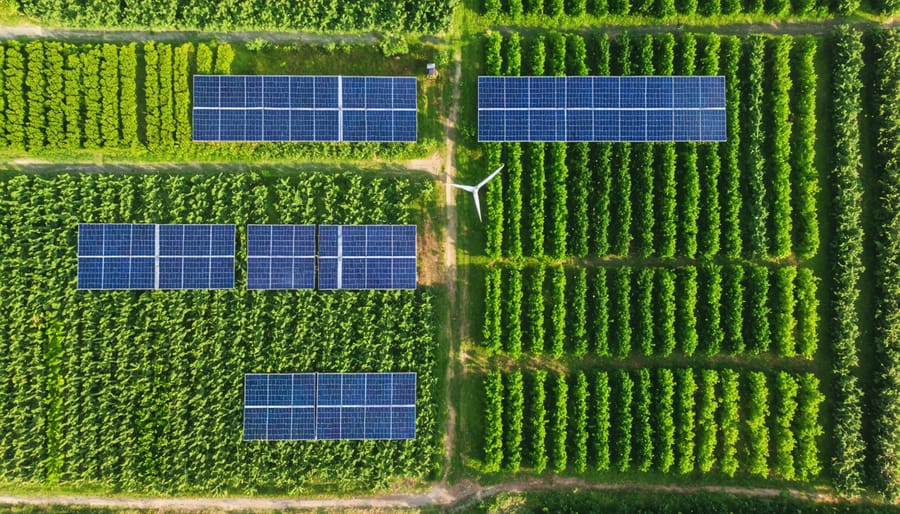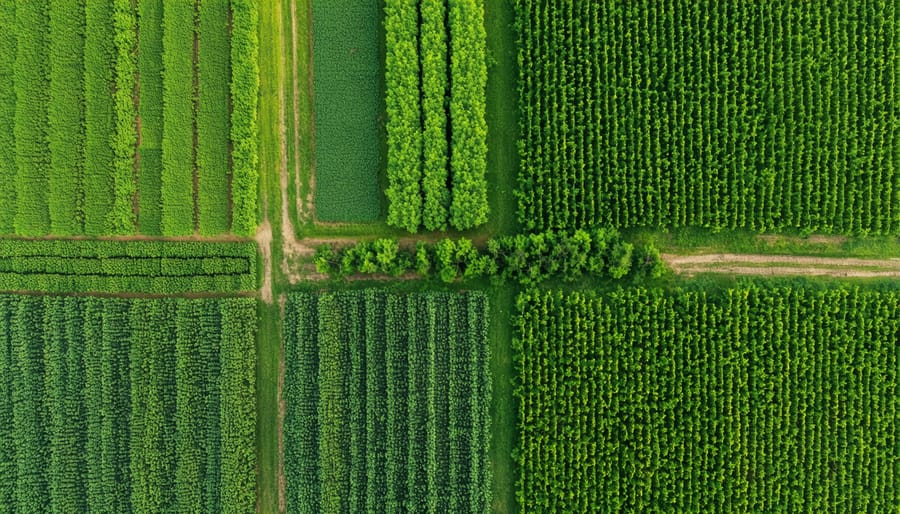1. Observe and Interact
The first principle of permaculture encourages farmers to closely observe their land and the natural systems at work. By taking time to watch, listen, and interact with the environment, growers can better understand the unique characteristics, patterns, and rhythms of their farm. For example, an Alberta farmer might note how water flows through their property during spring melt or which areas receive the most sunlight. This knowledge allows them to design their farm in harmony with nature, placing crops, animals, and infrastructure in the most suitable locations. Observing wildlife, such as noticing which plants attract beneficial insects, can also guide planting decisions. Applying this principle involves regularly monitoring the land, keeping records, and adapting management practices based on observations. Understanding aspects like water infiltration can further enhance a farmer’s ability to work with natural processes. By working with nature rather than against it, farmers can create more resilient and productive systems that require fewer external inputs and interventions.

2. Catch and Store Energy
Harnessing and conserving energy is crucial for sustainable farming. Solar panels can be installed to generate electricity for powering farm equipment, lighting, and heating. Wind turbines are another renewable energy option, particularly in open, windy areas. Proper water management, such as collecting rainwater in cisterns or ponds for irrigation during dry spells, conserves this precious resource. Planting windbreaks and shelterbelts can reduce erosion and evaporation while providing habitat for beneficial insects and wildlife. Composting and mulching help retain moisture in the soil, reducing the need for watering. Learn more about harvesting the power of green energy through methods like Alberta’s wind farms, which demonstrate how energy-saving strategies can lower environmental impact and operating costs while building resilience against climate change. As stewards of the land, embracing renewable energy and conservation is both a responsibility and an opportunity for Canadian farmers to lead the way in sustainable agriculture.
3. Obtain a Yield
Designing systems that yield useful outputs is a core principle of permaculture. By strategically planning your farm or garden to produce crops, raise livestock, and create value-added products, you can optimize your land’s productivity while minimizing waste. Consider companion planting, where certain crops are grown together to enhance growth and deter pests, or integrating animals like chickens or ducks to help with pest control and soil fertilization. Harvesting rainwater and using efficient irrigation techniques can also boost yields. Embrace a diverse range of plants and animals to create a resilient ecosystem that provides an abundance of food, fiber, and other resources. Remember, the goal is not just to maximize output but to cultivate a sustainable and self-sufficient system that nourishes both the land and the people who depend on it.
4. Apply Self-Regulation and Accept Feedback
Sustainable systems are built on constant observation, feedback, and adaptation. By closely monitoring your land and crops, you can identify areas for improvement and make necessary adjustments. This might involve tweaking irrigation, adjusting companion planting, or exploring renewable inputs. Accepting feedback, whether from the land itself or experienced mentors, allows for continual refinement and resilience.
Self-regulation is key – aim to create closed-loop systems that maintain their own health with minimal external inputs. This could include using green manures to boost soil fertility, or planting native species that thrive without intervention. By working with nature’s cycles and rhythms, you create a harmonious, self-sustaining ecosystem that can weather challenges and changes over time. Embrace an attitude of lifelong learning, and be open to experimenting and evolving your approach as you deepen your understanding of your land’s unique needs and potential.
5. Use and Value Renewable Resources and Services
Permaculture encourages the use of renewable resources and services to minimize reliance on non-renewable inputs. In Alberta, this can be achieved by harnessing solar energy for passive heating and electricity generation, capturing rainwater for irrigation, and using wind power where appropriate. Composting organic waste and utilizing green manures can help build soil fertility without relying on synthetic fertilizers. Planting nitrogen-fixing cover crops like alfalfa or clover can reduce the need for external nitrogen inputs. Incorporating perennial plants and agroforestry systems can provide long-term yields while enhancing ecosystem services such as carbon sequestration and biodiversity. By prioritizing renewable resources and working with natural processes, Alberta farmers can create more self-sufficient and resilient agricultural systems that minimize environmental impact and reduce dependence on finite resources. Practices like regenerative farming not only benefit the environment but can also lead to long-term cost savings and increased self-reliance for farm operations.

6. Produce No Waste
Reducing waste is a key tenet of permaculture. On the farm, this means finding creative ways to reuse, repurpose, and recycle materials that might otherwise end up in the landfill. Composting is an excellent way to turn organic waste like food scraps, garden trimmings, and even animal manure into nutrient-rich soil amendments. Collecting rainwater for irrigation not only conserves this precious resource but also reduces runoff and erosion. Repurposing old tools, lumber, and other materials for new projects saves money and keeps them out of the waste stream. By thinking holistically about the farm as a closed-loop system, permaculture practitioners strive to minimize external inputs and waste outputs. This not only benefits the environment but also creates a more self-sufficient and resilient operation. With a little ingenuity, what might seem like waste can become a valuable asset in the permaculture toolkit.
7. Design from Patterns to Details
When designing a permaculture system, start by observing the natural patterns and principles at play in your landscape. Look at the big picture: the topography, water flow, wind patterns, and sun exposure. Identify sectors and zones to organize elements efficiently. Then, gradually refine the details, such as specific plant placements, microclimates, and companion planting. Use nature’s patterns, like spirals and curves, to create aesthetically pleasing and productive designs. Iterate and adapt your plan as you observe how the system evolves over time. For example, a Canadian farmer might begin by mapping their property’s contours and water courses, then place key infrastructure like barns and greenhouses. Next, they would fill in the finer details, such as choosing native plant guilds and designing efficient pathways. By working from patterns to details, you can create a harmonious, resilient system that optimizes natural processes.
8. Integrate Rather Than Segregate
By integrating rather than segregating elements in a permaculture system, we can create synergies that enhance productivity and resilience. For example, planting nitrogen-fixing legumes alongside heavy-feeding crops nourishes the soil and reduces the need for external inputs. Integrating livestock, such as chickens, into orchards or vegetable gardens helps with pest control, fertilization, and soil aeration. Companion planting, where mutually beneficial plants are grown together, is another powerful way to integrate elements. The key is to design multi-functional systems where each component serves multiple purposes and supports the others. This principle encourages us to look for connections and relationships in our landscapes, rather than seeing them as isolated parts. By working with nature’s inherent tendency towards integration, we can create more efficient, self-sustaining, and harmonious agricultural ecosystems that benefit both the environment and the farmer.
9. Use Small and Slow Solutions
Permaculture encourages the use of small and slow solutions that are easier to manage and adapt over time. By starting with localized, manageable projects, farmers can gain valuable experience and make adjustments as needed without overwhelming their resources. This principle emphasizes the importance of patience and long-term thinking in creating sustainable agricultural systems. Small-scale solutions, such as establishing a diverse vegetable garden or implementing a rainwater harvesting system, can serve as learning opportunities and provide a foundation for future growth. As these solutions prove successful, they can be gradually expanded and replicated across the farm. By taking a slow and steady approach, farmers can develop resilient systems that are better equipped to handle challenges and changes in the long run. Embracing small and slow solutions allows for continuous improvement and adaptation, ensuring that the farm remains sustainable and productive for generations to come.
10. Use and Value Diversity
Diversity is a key ingredient in resilient, stable ecosystems and farms. By cultivating a wide range of plants, animals, and microorganisms, permaculture systems can better withstand challenges like pests, diseases, and climate variability. This biodiversity also provides diverse income streams, reducing reliance on a single crop or product. For instance, a farmer might grow a variety of fruits and vegetables, raise chickens for eggs and meat, and sell value-added products like jams or honey. This diversity spreads risk and ensures a steadier flow of income throughout the year. Embracing diversity also means valuing different perspectives, skills, and knowledge within the farming community. By collaborating and sharing insights, farmers can innovate, problem-solve, and build a stronger, more adaptable agricultural system. Ultimately, diversity – in all its forms – is essential for creating a vibrant, resilient future for Canadian agriculture.

11. Use Edges and Value the Marginal
In permaculture, edges and marginal spaces are seen as valuable assets rather than unproductive areas. By embracing the principle of using edges and valuing the marginal, Canadian farmers can enhance biodiversity, create microclimates, and boost overall productivity on their land. Edges, such as the borders between fields or the transition zones between ecosystems, are hotspots for life and provide unique niches for various species to thrive. Marginal spaces, like rocky outcrops or wetlands, can offer essential ecosystem services and support beneficial wildlife. By strategically planting along edges and in marginal areas, farmers can create windbreaks, attract pollinators, and improve soil health. This approach requires adaptability and innovation, as each edge and marginal space presents its own challenges and opportunities. However, by seeing challenges as opportunities and working with the unique characteristics of their land, farmers can unlock the potential of these often-overlooked spaces and create more resilient, diverse, and productive agroecosystems.
12. Creatively Use and Respond to Change
In permaculture, change is seen as an opportunity for growth and improvement. By embracing adaptability and innovation, farmers can build resilience in the face of evolving conditions. This principle encourages practitioners to observe changes in their environment, such as shifting weather patterns or new pests, and creatively respond with adjustments to their systems. For instance, Alberta farmers facing increasingly dry summers might experiment with drought-tolerant crops or water-saving irrigation techniques. By staying open to new ideas and solutions, permaculturists can turn challenges into chances to strengthen their farms and communities. Ultimately, this principle empowers farmers to be proactive, resourceful, and ready to learn from both successes and setbacks as they work towards a more sustainable future.
Conclusion
In conclusion, the 12 principles of permaculture provide a comprehensive framework for designing sustainable and resilient agricultural systems. By embracing concepts like observing and interacting with nature, catching and storing energy, obtaining a yield, applying self-regulation, using renewable resources, producing no waste, designing from patterns to details, integrating rather than segregating, using small and slow solutions, valuing diversity, using edges, and creatively responding to change, Canadian farmers can create thriving, regenerative farms that support both human and ecological well-being.
As you embark on your permaculture journey, remember that these principles are not rigid rules but rather guiding insights to be adapted to your unique context. Whether you’re managing a large-scale operation in Alberta or a small homestead, you can apply permaculture principles to enhance soil health, biodiversity, and overall farm resilience.
To further your understanding and practical application of permaculture, consider exploring resources like the Permaculture Association of Alberta, attending workshops and courses, and connecting with fellow permaculture practitioners in your community. By working together and sharing knowledge, we can create a more sustainable and vibrant agricultural landscape across Canada.











